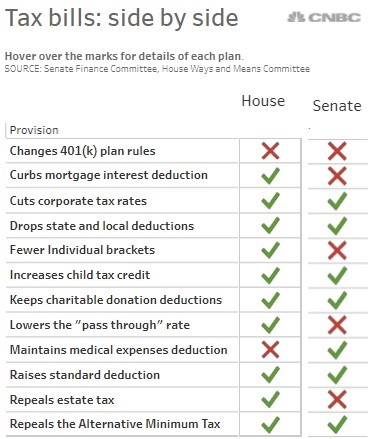Tax Plan To Be Worked Out This Week
Last Thursday the Senate released its plan to cut taxes which sent the market falling because the tax cuts start in 2019. The Senate’s amendment process starts on Monday. That’s when the details will be hashed out. We will probably see the market move on headlines regarding the debate. It’s the main event hanging over the market given the fact that the economy is thought to be stable, earnings season is largely over, and President Trump picked Powell as Fed chair. The House Ways and Means Committee put out its version of the tax plan on Thursday. There will be a vote on that plan next week. As you can see, the House is ahead of the Senate. Afterward both chambers pass a plan, the differences between each plan will need to be reconciled.
The chart below reviews the differences between the two plans. As you can see, the Senate plan keeps the same number of tax brackets. That seems to go against the idea of simplifying the tax code. We’re very far from the campaign promise of being able to fill out your taxes on the back of a postcard. Many will see a tax increase because of the elimination of the state and local tax deductions. The House plan will add $1.7 trillion to the national debt, meaning the promise to not increase the debt will also be broken. If conservatives decide this plan increases the debt too much, it will be dead on arrival. Because the Senate plan gets rid of all the state and local tax deductions and the House plan lets taxpayers deduct up to $10,000 in property taxes, I think the Senate plan will end up raising the debt less. The maximum increase under the reconciliation rules is $1.5 trillion.

ECB Tapering
As I discussed in a previous article, the reinvestment of the maturing bonds will counteract the ECB’s tapering in 2018. I didn’t explain it as well as I should have. The reinvestments are large because the balance sheet has expanded rapidly in the past few years. While the new bond buying will fall from 60 billion euros per month to 30 billion euros per month, Goldman expects the reinvestments to be 10 billion euros per month. That means the tapering is much softer than initially reported.











Leave A Comment